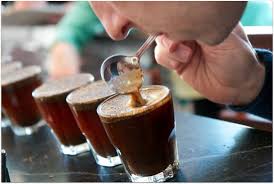It may seem excessive or snobbish, but it would be a shame to take a premium specialty-roast coffee or a fine tea and brew it in regular old tap water. Coffee and tea are nearly 99 percent water, making good water quality essential to the final product.
A great, basic tutorial on green coffee processing. Full article appears on forbes.com.
Topics: Coffee & Espresso
Before you sign a lease for your new coffeehouse, you’ll need a solid plan for exactly how you’ll use the space—not to mention assuring your location is visible and the lease is amenable.
Topics: Layout & Design

As a follow up to our coffee cupping guide, here's a handy guide for taking cupping notes — which, for the novice cupper, can sometimes seem like five ways to say the same thing.
Topics: Training, Coffee & Espresso
It’s a weird word, cupping. Yet it's just ground coffee and hot water, with no fancy brewing process to affect its flavor. It’s what you’ve got to do to evaluate the characteristics of coffees, to understand their nuances — their basic tastes and defects — and how they compare to other coffees. And it’s something you can share with your customers with weekly or monthly cupping events — perhaps during a slower weekend hour.
Topics: Training, Staff Management
Dairy milk may still rule the latte universe, but a variety of non-dairy milks have been threatening its dominance since soy milk started showing up in cappuccino cups in the ’90s. And with almond and hemp milks — and even macadamia, cashew and coconut — to contend with, baristas can find themselves juggling a variety of steaming techniques as they try not to burn non-dairy milks while getting them hot enough to add to espresso.
Topics: Alternative Milks
Tea is all about soothing flavor — flavor that whispers instead of shouting. Tea infusions are a subtle touch that add a gourmet feel to other beverages, and can enable anyone to develop a signature drink that is truly unique.
Topics: Recipes, Teas & Chai


.png)